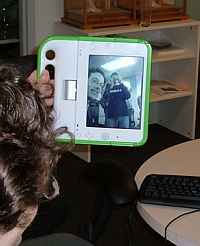Now that Children's Machine XO-1 test laptops are on their way to Argentina and Brazil, but we are still ISO an OLPC implementation plan it's interesting to think of how the One Laptop Per Child computers could be used outside the classroom.
Reading Ethan Zuckerman's review of the OLPC XO, I was struck by his "eureka!" moment:
The "eureka" moment for me came when I hit one of the icons and suddenly found myself staring into my own face. The machine has a pinhole video camera for videoconferencing - SJ reports that video has been so popular with early users that the team is looking for ways to let students make and share short videos.Its no surprise that imaging, both video and still, is wildly popular across all socio-economic sectors. We can look to Flickr and YouTube for easy confirmation in the developed world.
But if you take this to the environments the OLPC is designed for, countries, communities, people who currently do not have the means or the ability to create digital content in mass numbers, countries where digital photo capture and printing are in high demand and one of the few profitable services in rural and poor areas, and I see great opportunity.
Imagine people setting up micro-businesses, digital photo booths where entrepreneurial OLPC-equipped students who invest in a color photo printer and serve as the community's photojournalists. Or where OLPC-equipped children serve as videographers at weddings, funerals, any life-changing event. Or kids just have fun taking videos and pictures of what's around them.
Now multiply that content by five million OLPC XO’s in the first production run and YouTube or Flickr seem tiny, minuscule, only the beginning.
And then the OLPC implementation miracle doesn't seem so magical after all.



On that 'entrepreneur' note: if the kids can do that, adults can too, and the kids could easily be tempted to sell their laptops to the highest bidder. The gray market doesn't just exist on eBay after all.
As I have said before, these computers are going to wind being used by everyone in the village, and for a thousand different functions. And that will make the project an enormously good economic investment.
Remember, this is not like school-issued laptops in the US, where you are giving them to families who in most cases already have one or more computers. Instead it will be a whole networked system of computers in villages that have never had even one. The computer is the most flexible invention since writing, and there will be just an endless number of uses the villagers will think of for them.